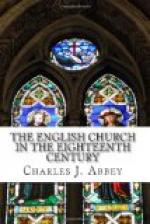Before the publication of Bishop Bull’s first great work in 1685, no controversial treatise on either side of the question—none, at least, of any importance—was published in this country, though there had of course been individual anti-Trinitarians in England long before that time.
A few words on the ‘Defensio Fidei Nicaenae’ will be a fitting introduction to the account of the controversy which belongs properly to the eighteenth century. Bishop Bull’s defence was written in Latin, and was therefore not intended for the unlearned. It was exclusively confined to this one question: What were the views of the ante-Nicene Fathers on the subject of the Trinity, and especially on the relation of the Second to the First Person? But though the work was addressed only to a very limited number of readers, and dealt only with one, and that a very limited, view of the question, the importance of thoroughly discussing this particular view can scarcely be exaggerated for the following reason. When, the attention of any one familiar with the precise definitions of the Catholic Church which were necessitated by the speculations of Arians and other heretics is called for the first time to the writings of the ante-Nicene Fathers, he may be staggered by the absence of equal definiteness and precision in them. Bishop Bull boldly met the difficulties which might thus occur. He minutely examined the various expressions which could be wrested into an anti-Trinitarian sense, showing how they were compatible with the Catholic Faith, and citing and dwelling upon other expressions which were totally incompatible with any other belief. He showed that the crucial test of orthodoxy, the one single term at which Arians and semi-Arians scrupled—that is, the Homoousion or Consubstantiality of the Son with the Father—was actually in use before the Nicene Council, and that it was thoroughly in accordance with the teaching of the ante-Nicene Fathers. This is proved, among other ways, by the constant use of a simile which illustrates, as happily as earthly things can illustrate heavenly, the true relation of the Son to the Father. Over and over again this is compared by the early fathers to the ray of light which proceeding from the sun is a part of it, and yet without any division or diminution from it, but actually consubstantial with it. He fully admits that the early fathers acknowledged a certain pre-eminence in the First Person, but only such a pre-eminence as the term Father suggests, a pre-eminence implying no inequality of nature, but simply a priority of order, inasmuch as the Father is, as it were, the fountain of the Deity, God in Himself,[431] while the Son is God of God, and, to recur to the old simile incorporated in the Nicene Creed, Light of Light.[432]
Bishop Bull’s two subsequent works on the subject of the Trinity (’Judicium Ecclesiae Catholicae’ and ‘Primitiva et Apostolica Traditio’) may be regarded as supplements to the ‘Defence.’ The object of the ‘Judicium’ was to show, in opposition to Episcopius, that the Nicene fathers held a belief of Our Lord’s true and proper divinity to be an indispensable term of Catholic communion; his latest work was directed against the opinion of Zuicker that Christ’s divinity, pre-existence, and incarnation were inventions of early heretics.[433]




